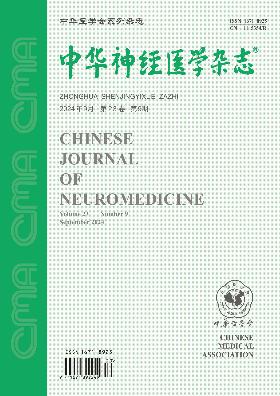Risk factors for pulmonary infection in severe neurological patients
Q4 Medicine
引用次数: 0
Abstract
Objective To analyze the influencing factors for pulmonary infection in neurosurgical critical patients, and provide references for prevention and treatment of pulmonary infection. Methods Sixty-five patients with severe neurological diseases complicated with pulmonary infection, admitted to our hospital from May 2017 to May 2018, were chosen in our study. General information, laboratory examination results, chest CT and other imaging results, hospital stay, antibiotic/ventilator use, tracheotomy and other treatments of these patients were collected and compared to identify the independent factors influencing pulmonary infection in patients with severe neurological disease. Results There was a statistically significant difference in incidence of pulmonary infection among patients with different diseases (P<0.05), and the infection rate of patients with cerebral hemorrhage was the highest, reaching to 50.8% (32/63). GCS scores (OR=2.903, 95%CI: 1.069-7.881, P=0.037), serum albumin level (OR=3.690, 95%CI: 1.157-11.768, P=0.027), ventilator use (OR=15.799, 95%CI: 6.305-39.591, P=0.000), tracheotomy or endotracheal intubation (OR=7.036, 95%CI: 2.913-16.993, P=0.000), history of diabetes (OR=2.442, 95%CI: 1.026-5.809, P=0.043), and prophylactic use of antibiotics (OR=6.021, 95CI%: 2.340-15.489, P=0.000) were independent risk factors for pulmonary infection in patients with severe neurological conditions. Conclusion Effective measurements, including recovering consciousness as soon as possible, shortening accommodation, actively avoiding endotracheal intubation and ventilator-associated pneumonia, and rectifying hypoproteinemia and diabetes mellitus can effectively prevent the occurrence of severe pulmonary infection of neurosurgical critical patients. Key words: Severe nervous system; Pulmonary infection; Influencing factor重症神经系统患者肺部感染的危险因素
目的分析神经外科危重患者肺部感染的影响因素,为肺部感染的防治提供参考。方法选取2017年5月至2018年5月我院收治的重症神经系统疾病合并肺部感染患者65例。收集这些患者的一般资料、实验室检查结果、胸部CT等影像学结果、住院时间、抗生素/呼吸机使用情况、气管切开术等治疗情况进行比较,以确定严重神经系统疾病患者肺部感染的独立影响因素。结果不同疾病患者肺部感染发生率比较,差异有统计学意义(P<0.05),以脑出血患者感染率最高,达50.8%(32/63)。GCS评分(OR=2.903, 95%CI: 1.069 ~ 7.881, P=0.037)、血清白蛋白水平(OR=3.690, 95%CI: 1.157 ~ 11.768, P=0.027)、使用呼吸机(OR=15.799, 95%CI: 6.305 ~ 39.591, P=0.000)、气管切开或气管内插管(OR=7.036, 95%CI: 2.913 ~ 16.993, P=0.000)、糖尿病史(OR=2.442, 95%CI: 1.026 ~ 5.809, P=0.043)、预防性使用抗生素(OR=6.021, 95%CI %: 2.340 ~ 15.489, P=0.000)是严重神经系统疾病患者肺部感染的独立危险因素。结论尽快恢复意识、缩短住宿时间、积极避免气管插管和呼吸机相关性肺炎、纠正低蛋白血症和糖尿病等有效措施可有效预防神经外科危重患者严重肺部感染的发生。关键词:重症神经系统;肺部感染;影响因素
本文章由计算机程序翻译,如有差异,请以英文原文为准。
求助全文
约1分钟内获得全文
求助全文
来源期刊

中华神经医学杂志
Psychology-Neuropsychology and Physiological Psychology
CiteScore
0.30
自引率
0.00%
发文量
6272
期刊介绍:
 求助内容:
求助内容: 应助结果提醒方式:
应助结果提醒方式:


